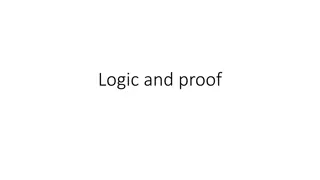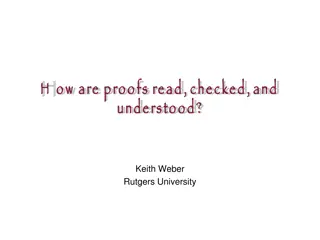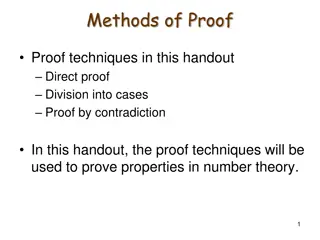Evolution of Proof Systems in Mathematics: From Euclid to Godel
Exploring the journey of proof systems in mathematics from Euclid's era to Godel's incompleteness theorem, highlighting the challenges and evolution in understanding truth, halting problems, and the impact on number theory. The concept of designing a proof system that proves everything and the implications of worldviews on truth are discussed through historical perspectives and key findings in mathematical logic.
Uploaded on Sep 21, 2024 | 0 Views
Download Presentation

Please find below an Image/Link to download the presentation.
The content on the website is provided AS IS for your information and personal use only. It may not be sold, licensed, or shared on other websites without obtaining consent from the author. Download presentation by click this link. If you encounter any issues during the download, it is possible that the publisher has removed the file from their server.
E N D
Presentation Transcript
CSE 2001 No Proof System for Number Theory Reduction to Halting Problem History G del's Incompleteness Halting Math Truth Jeff Edmonds York University Lecture6.3 COSC 2001
History of Proofs History of Proofs Euclid said, Let there be proofs Euclid (300 BC) And it was good.
History of Proofs History of Proofs Euclid said, Let there be proofs Clearly everything is either true or false. Goal: Design a proof system that proves everything. Result: Prove that God exists Euclid (300 BC)
History of Proofs History of Proofs Euclid said, Let there be proofs A proof system consists of 1. A finite set of axioms (Statements assumed to be true) Eg. 1) Any two points can be joined by a straight line . 5) Parallel lines never meet. Euclid (300 BC)
History of Proofs History of Proofs Euclid said, Let there be proofs A proof system consists of 1. A finite set of axioms (Statements assumed to be true) 2. A finite set of rules for proving one statement from previously proved theorems. Eg: If statements A and A B have been proved, then statement B follows. Euclid (300 BC)
History of Proofs History of Proofs To the ancients, the parallel axiom 5) Parallel lines never meet. seemed less obvious than the others. (God would want a cleaner world) They wanted to prove it from the other four. By 1763 at least 28 different proofs had been published. They were all false!!! Euclid (300 BC) There exist Non-Euclidian (curved) worlds in which first the four axioms are true and the fifth is false. Examples: Earth & Our universe.
History of Proofs History of Proofs Euclid said, Let there be proofs Clearly everything is either true or false. Oops Some things have no proof and whether true or false depends on your world view. Choose which world you want to live in and build that into your axioms. Eg Axiom: Homosexuals are bad. Euclid (300 BC) good
History of Proofs History of Proofs Euclid said, Let there be proofs Clearly everything is either true or false. Consider only statements in Number Theory i.e. statements about the integers. eg: = [ a,b,c,r 3 ar+br cr] Clearly each such statement is either true or false. Euclid (300 BC) Goal: Design a proof system that proves/disproves all of these.
Gdels Incompleteness Theorem Some things have no proof and whether true or false depends on your world view. For every proof system S, there are math statements which are either not proved or proved incorrectly! G del 1931
Gdels Incompleteness Theorem G del 1931 Proof System: If S is a valid proof system, then is true has a valid proof P in S Number Theory: eg: = [ a,b,c,r 3 ar+br cr] Is powerful enough to say true= P is a valid proof of math statement I in proof system S. And hence can a say diagonal = P P is a valid proof of math statement diagonal in proof system S.
Gdels Incompleteness Theorem G del 1931 Proof System: If S is a valid proof system, then is true has a valid proof P in S Number Theory: eg: = [ a,b,c,r 3 ar+br cr] Is powerful enough to say diagonal = P P is a valid proof of math statement diagonal in proof system S. Incompleteness Proof: If S is a valid proof system, diagonal is true diagonal has a valid proof in S diagonal is true diagonal is false Oops Contradiction!
Gdels Incompleteness Theorem Turing 1936 Computational Problem: MathTruth( ) = Math Statement is true. Proof System: If S is a valid proof system, then a proof P of is a witness that is true & a proof P of is a witness that is not true, making MathTruth computable. Number Theory eg: I = [ a,b,c,r 3 ar+br cr] Is powerful enough to say halt= TM M halts on I. Hence, HaltingProblem poly MathTruth Incompleteness Proof: If S is a valid proof system, MathTruth is computable HaltingProblem is computable Oops Contradiction!
S valid proof system MathTruth computable Acceptable Co-Acceptable Yes instance Run forever or answer yes No instance Halt and answer no Yes instance Halt and answer yes No instance Run forever or answer no MathTruth with Proof System S Computable Yes instance Halt and answer yes No instance Halt and answer no Alg for MathTruth( ): Loop through all proofs P if P is a proof in S of or of . exit with yes or no Witness of yes . Witness of no . MathTruth with Proof System S with Proof System S MathTruth
S valid proof system MathTruth computable Acceptable Co-Acceptable Yes instance Run forever or answer yes No instance Halt and answer no Yes instance Halt and answer yes No instance Run forever or answer no Computable Yes instance Halt and answer yes No instance Halt and answer no Halting Problem Halting Problem MathTruth
S valid proof system MathTruth computable Alg for MathTruth( ): Loop through all proofs P if P is a proof in S of or of . exit with yes or no But what if neither has no proof? Then this algorithm runs forever. Will this algorithm ever stop? It reminds me of the Halting problem!
S valid proof system MathTruth computable Alg for MathTruth( ): Loop through all proofs P if P is a proof in S of or of . exit with yes or no If S is a valid proof system, then When MathTruth( ) = yes a proof P witnessing it. Alg halts with yes . When MathTruth( ) = no MathTruth( ) = yes a proof P witnessing it. Alg halts with no .
Halting problem poly Math Truth TM M halts on input I or not <M,I> Math statement: TM M halts on input I Math statement is true or not BUILD: Halting Oracle GIVEN: Math Proof Oracle
Halting problem poly Math Truth Math statement: TM M halts on input I = C, C is an integer encoding a valid halting computation for TM M on input I A valid computation of a TM Time state Tape Contents Head 1 102 [0,1,1,0,0,1,1] 2 10112 [1,1,1,0,0,1,1] Mark Head with digit 2 i 11012 [0,0,1,1,0,0,1,1,0] i+1 10102 [0,0,1,1,1,0,1,1,0] T 1102 [0,0,1,1,1,0,1,0,1,0]
Halting problem poly Math Truth Math statement: TM M halts on input I = C, C is an integer encoding a valid halting computation for TM M on input I A valid computation of a TM Time state Tape Contents Head 2 1 102 [2,0,1,1,0,0,1,1] 2 10112 [1,2,1,1,0,0,1,1] Mark Head with digit 2 with digits 3,4 Separate blocks i 11012 [0,0,1,1,2,0,0,1,1,0] i+1 10102 [0,0,1,2,1,1,0,1,1,0] T 1102 [2,0,0,1,1,1,0,1,0,1,0]
Halting problem poly Math Truth Math statement: TM M halts on input I = C, C is an integer encoding a valid halting computation for TM M on input I A valid computation of a TM Time state Tape Contents Head 2 4 10 3 [2,0,1,1,0,0,1,1] 4 1011 3 [1,2,1,1,0,0,1,1] Separate blocks with digits 3,4 Remove [,] 4 1101 4 1010 3 [0,0,1,2,1,1,0,1,1,0] 3 [0,0,1,1,2,0,0,1,1,0] 4 110 3 [2,0,0,1,1,1,0,1,0,1,0]
Halting problem poly Math Truth Math statement: TM M halts on input I = C, C is an integer encoding a valid halting computation for TM M on input I A valid computation of a TM Time state Tape Contents Head 2 4 10 3 2 0 1 1 0 0 1 1 4 1011 3 1 2 1 1 0 0 1 1 Remove [,] Merge Digits 4 1101 4 1010 3 0 0 1 2 1 1 0 1 1 0 3 0 0 1 1 2 0 0 1 1 0 4 110 3 2 0 0 1 1 1 0 1 0 1 0
Halting problem poly Math Truth Math statement: TM M halts on input I = C, C is an integer encoding a valid halting computation for TM M on input I An integer C encoding a valid computation of a TM C = 41032011001141011312110011 411013001120011041010300121101104 4110320011101010
Halting problem poly Math Truth Math statement: C is an integer encoding a valid halting computation for TM M on input I The initial config is that for TM M on input I time t a legal TM M step is taken The final config is halting for TM M = An integer C encoding a valid computation of a TM C = 41032011001141011312110011 411013001120011041010300121101104 4110320011101010
Halting problem poly Math Truth Math statement: time steps t the i digits are 4s, the jdigits are 3s, the kdigits are 2s, and every digit in between is 0 or 1. indexes i1<j1<k1<i2<j2<k2<i3 where = An integer C encoding a valid computation of a TM C = 41032011001141011312110011 411013001120011041010300121101104 4110320011101010 i1 j1 i2 j2 k1 k2 i3
Halting problem poly Math Truth Math statement: time steps t = indexes i1<j1<k1<i2<j2<k2<i3 Cut out from index i1 to j1. An integer C encoding a valid computation of a TM C = 41032011001141011312110011 411013001120011041010300121101104 4110320011101010 x = C/10j = 41032011001141011312110011 41101 y = C/10i-1 10i-j-1 = 41032011001141011312110011 40000 i1 j1 i2 j2 k1 k2 i3 x-y = 1011
Halting problem poly Math Truth Math statement: time steps t Cut out state, tape, head, digit at head = indexes i1<j1<k1<i2<j2<k2<i3 Cut out next state, tape, head, digit at old head An integer C encoding a valid computation of a TM C = 41032011001141011312110011 411013001120011041010300121101104 4110320011101010 i1 j1 i2 j2 k1 k2 i3 statet = 1101 tapet = 001100110 digit at headt = 0 statet+1 = 1101 tapet+1 = 001110110 digit at old headt+1 = 1
Halting problem poly Math Truth Math statement: a legal TM M step is taken to M s finite rules = Cell at head, head position, and state change according index i, if cell has no head then no change to cell An integer C encoding a valid computation of a TM C = 41032011001141011312110011 411013001120011041010300121101104 4110320011101010 statet = 1101 tapet = 001100110 digit at headt = 0 statet+1 = 1101 tapet+1 = 001110110 digit at old headt+1 = 1
Halting problem poly Math Truth TM M halts on input I or not <M,I> Math statement: TM M halts on input I Math statement is true or not BUILD: Halting Oracle GIVEN: Math Proof Oracle
Gdels Incompleteness Theorem Turing 1936 Computational Problem: MathTruth( ) = Math Statement is true. Proof System: If S is a valid proof system, then a proof P of is a witness that is true & a proof P of is a witness that is true, making MathTruth computable. Number Theory eg: I = [ a,b,c,r 3 ar+br cr] Is powerful enough to say halt= TM M halts on I. Hence, HaltingProblem poly MathTruth Incompleteness Proof: If S is a valid proof system, MathTruth is computable HaltingProblem is computable Oops Contradiction!
The End The End























